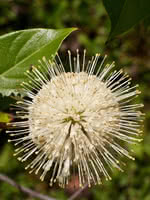Mon-Fri 9am - 5pm Mountain time
Buttonbush vs Blue Flax
Cephalanthus occidentalis
Linum lewisii
CUSTOM GROW
NOT AVAILABLE THIS SEASON - MIGHT RETURN
Buttonbush is a moisture loving shrub that provides year round interest.
It has round, fragrant flowers resembling small buttons or pincushions. The flowers transform into small reddish-brown fruit that persists into winter while the leaves take on shades of red in fall.
Providing essential food to bees, butterflies, and other insects, this shrub is versatile. Try it in your next shrub border.
Blue Flax is a native perennial wildflower known for its blue to violet flowers. Each flower lasts just a single day, but new blooms appear continuously, providing weeks of colour. This extended flowering period provides a reliable display from late spring into summer and attracts a variety of pollinators.
They can self-seed readily, so removing spent blooms helps manage their spread. Birds feed on the seeds, and when cooked, they are edible and are described as having a mild, nutty flavour. The plant grows in loose clumps with slender stems and fine foliage. Young plants are leafy, but as they mature, most leaves are shed.
Blue Flax grows well in a wide range of soils, including poor or sandy conditions, and is drought-tolerant once established. The deep root system helps to stabilize soil and prevent erosion. They are well-suited for pollinator gardens, restoration, naturalization, and xeriscaping projects.
Buttonbush Quick Facts
Blue Flax Quick Facts
Toxicity: toxic to some animals, raw seed toxic

